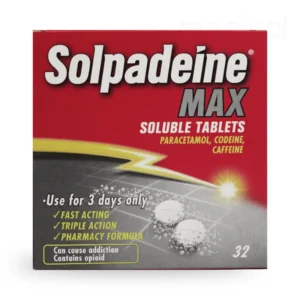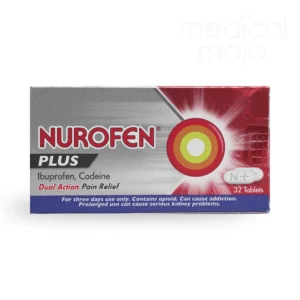Codeine is a widely used medication for treating mild to moderate pain, offering relief to millions worldwide. It is a trusted option for those seeking effective pain management, particularly when over-the-counter options like paracetamol or ibuprofen prove insufficient. Beyond pain relief, codeine is also effective in alleviating coughs and diarrhoea.
If you are considering using codeine, it’s vital to understand its uses, dosages, and side effects, ensuring safe and effective treatment. In this blog, we’ll explore the history of codeine, its common uses, who should avoid it, and how to use codeine compound products responsibly. For access to high-quality codeine compound products, check out Medical Mojo’s codeine-based treatments.
Use the navigational table below to skip to topics of interest.
-
 Solpadeine Plus Soluble Tablets (24)£7.99
Solpadeine Plus Soluble Tablets (24)£7.99 -
 Solpadeine Max Soluble Tablets (32)£9.99 – £14.99
Solpadeine Max Soluble Tablets (32)£9.99 – £14.99 -
 Nurofen Plus Tablets (32)£11.99
Nurofen Plus Tablets (32)£11.99
A brief history of codeine
Codeine’s origins trace back to 1832 when French chemist Pierre Robiquet isolated it from opium. Since then, it has become one of the most prescribed opioids in the world. Codeine belongs to a class of medications called opioids, derived from the opium poppy. While more potent opioids like morphine and heroin also derive from opium, codeine is often considered a “milder” opioid, primarily due to its lower risk profile when used as directed.
In the 20th century, codeine gained popularity as a safer alternative to stronger opioids for pain relief and as a key ingredient in combination medications designed to treat a variety of conditions, including coughs and gastrointestinal discomfort. Today, it remains a staple in many medical practices.
What is codeine typically used for?
Codeine is versatile in its applications, treating several conditions effectively:
- Pain Relief: Codeine is used to treat mild to moderate pain. It’s commonly found in compound products mixed with paracetamol or ibuprofen for enhanced efficacy.
- Cough Suppression: Codeine can reduce cough frequency and severity, often prescribed for persistent coughs.
- Diarrhoea: Due to its ability to slow intestinal movement, codeine may be used to treat diarrhoea in specific cases.
For comprehensive codeine-based products tailored to your needs, visit Medical Mojo’s shop.
Who should not take codeine products?
While codeine is effective for many people, certain individuals should avoid using it including:
- Children under 12 years old: The use of codeine is contraindicated due to potential severe breathing problems.
- People with respiratory issues: Conditions such as asthma or chronic obstructive pulmonary disease (COPD) increase the risk of breathing complications.
- Pregnant or breastfeeding women: Codeine can pass through the placenta or breast milk, potentially harming the baby.
- Individuals with a history of substance abuse: Due to its addictive properties, codeine may not be suitable.
- Those with liver or kidney problems: Codeine is metabolised in the liver, and impaired organ function can increase the risk of side effects.
Always consult a healthcare professional before starting codeine products to ensure safety.
Typical dose for codeine and how to take it
Codeine is often combined with other medications like paracetamol or ibuprofen to form compound products. Here is how to take it:
- Typical Dose: Adults usually take 15-60 mg of codeine every 4-6 hours as needed.
- Combination Products: For compound products such as those offered by Medical Mojo, adhere to the recommended dosage on the packaging. For example, codeine combined with paracetamol or ibuprofen enhances pain relief without requiring higher doses of codeine.
- Method of Administration: Codeine is typically available in tablets, capsules, or liquids. Take with water, and if it causes nausea, try taking it with food.
Explore Medical Mojo’s codeine compound products for tailored options that suit your needs.
Side effects of codeine
Like any medication, codeine can cause side effects. Most are mild but should not be ignored:
- Common Side Effects: Nausea, drowsiness, constipation, and dizziness.
- Less Common but Serious Side Effects: Breathing difficulties, confusion, or allergic reactions.
- How to Manage Side Effects: Stay hydrated, avoid alcohol, and discuss persistent or severe symptoms with a healthcare provider.
If you experience any concerning symptoms, stop taking the medication and consult a doctor immediately.
Common questions about codeine
1. Can you take naproxen with codeine?
Yes, naproxen (a nonsteroidal anti-inflammatory drug or NSAID) can be taken with codeine for enhanced pain relief. This combination is particularly useful for conditions involving inflammation and pain, such as arthritis or post-surgical recovery. However, always consult your healthcare provider before combining medications to ensure safety.
For more information on naproxen, check out our detailed blog on its uses and precautions, available at Medical Mojo.
2. How long does codeine stay in your system?
Codeine has a half-life of approximately 3-4 hours, meaning it takes this long for half of the dose to leave your system. However, the metabolites can linger longer:
- In urine: Generally speaking, codeine can even be detected for up to 2-3 days after the last dose. However, those who take codeine for longer periods of time, this window can be extended to 1 week.
- In blood: Up to 24 hours.
- In hair: Up to 90 days.
Factors like metabolism, age, and dosage can influence these timelines.
3. Is codeine addictive?
Yes, codeine can be addictive, especially if used in high doses or for prolonged periods. It activates opioid receptors in the brain, creating a sense of euphoria that may lead to dependence. To minimise the risk:
- Use the lowest effective dose for the shortest duration of time.
- Avoid using it recreationally or beyond prescribed limits.
- Consult your doctor if you suspect dependence.
Conclusion
Codeine is a valuable medication when used appropriately, offering relief for pain, coughs, and diarrhoea. However, it requires responsible use to avoid potential side effects or dependence. Always consult with a healthcare provider to ensure safe and effective treatment tailored to your needs.
For high-quality compound codeine products, visit Medical Mojo. Our range of codeine-based treatments is trusted by countless individuals for effective and reliable pain management.
Disclaimer: This article is for informational purposes only and is not a substitute for professional medical advice.
References
- Drugs.com. (n.d.). Codeine Information. [online] Available at: https://www.drugs.com/codeine.html.
- Zelus Recovery. (2023). How Long Does Codeine Stay in Your System? [online] Available at: https://www.zelusrecovery.com/addiction-blog/how-long-does-codeine-stay-in-your-system/.
- NICE. (2023). Analgesia – mild-to-moderate pain: weak opioids. [online] Available at: https://cks.nice.org.uk/topics/analgesia-mild-to-moderate-pain/management/weak-opioids/.
- NHS. (2023). Codeine Phosphate. [online] Available at: https://www.nhs.uk/medicines/codeine/.
- Mayo Clinic. (2023). Opioid Use and Addiction. [online] Available at: https://www.mayoclinic.org/diseases-conditions/opioid-use-disorder/symptoms-causes/syc-20355705.
- British National Formulary (BNF). (2023). Codeine – Indications and Doses. [online] Available at: https://bnf.nice.org.uk/drug/codeine.html.
- Healthline. (2023). What to Know About Codeine. [online] Available at: https://www.healthline.com/health/codeine.


